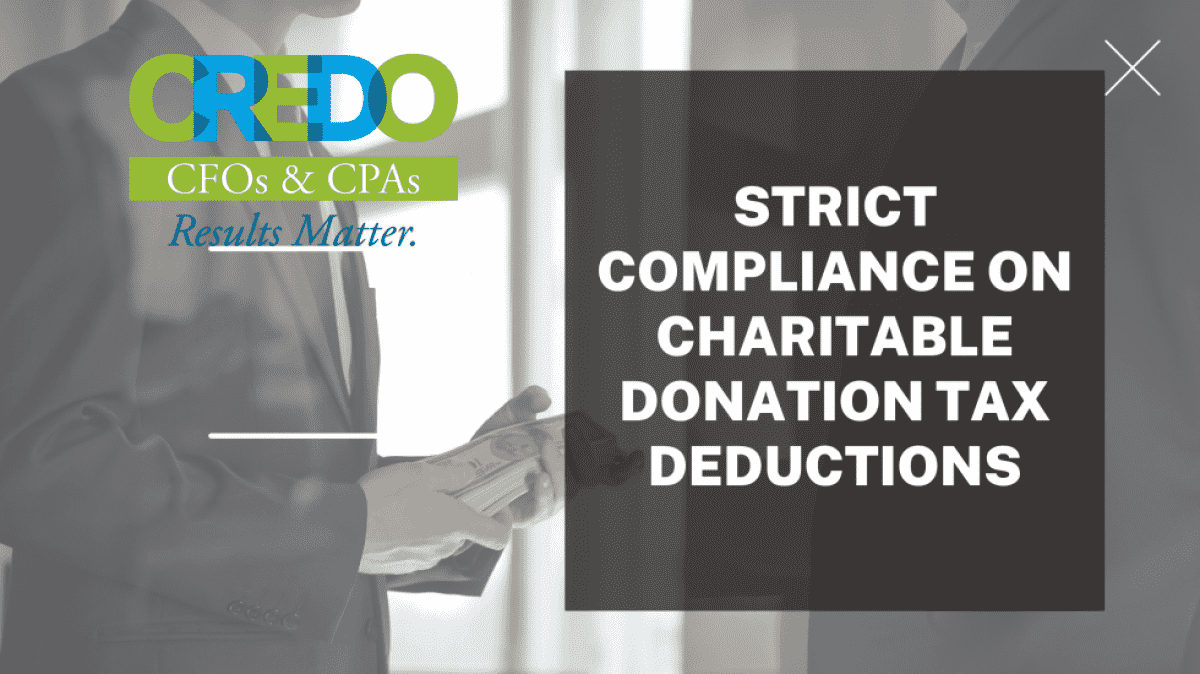Strict Compliance On Charitable Donation Tax Deductions

Donors must be aware of the specific regulations in order to avoid losing significant tax deductions.
Many people, both privately and publicly, are thinking about making charitable contributions as 2022 winds down. Donors must be aware of the specific regulations in order to avoid losing significant tax deductions in light of recent judicial decisions establishing “tight conditions” to claim tax deductions for charitable contributions. It is also vital for organizations that receive gifts to assess their gift receipt and reporting procedures to guarantee compliance with federal tax law and to avoid creating difficulties for donors who are attempting to claim such deductions.
The Fundamentals
Gifts to approved charities within the tax year can be written off. To be eligible, an organization must meet the requirements of Section 501(c)(3) of the Internal Revenue Code and have received a decision letter from the IRS stating that it is exempt from federal income tax (3).
Donors need to keep documentation showing the name of the organization, the date of the gift, and the amount given in order to claim tax deductions. This documentation might be in the form of a bank statement or a letter from the recipient organization. Additional conditions for a charitable deduction are listed below and vary according on the amount of the donation.
Charitable Receipt
Written documentation of a donation from the recipient organization, often known as a charitable receipt, is required for any donation above $250. A receipt can be in the form of a handwritten note of appreciation, an electronic message of thanks, or an annual report of donations. Any receipt issued by the recipient organization must contain the following information regardless of its format:
- The amount of money donated
- A description of any non-monetary donations (but not their value)
- An indication of whether or not the organization gave goods or services in exchange for the donation. (For instance, “No products or services were supplied in exchange for this donation,” may be printed on the acknowledgment slip.)
Any items or services delivered by the organization must be itemized, and their fair market value must be estimated on the receipt. This is a regular occurrence when a nonprofit organizes a gala or banquet and accepts donations to pay the expense of the dinner and to raise money for the nonprofit. All nonprofits should check their receipting practices to make sure they follow these guidelines to forestall any inquiries from contributors or the IRS.
Most recipients of donations also include the date and amount given on the receipt to accommodate the donor’s need to keep track of these details for tax purposes. The donor must have the receipt in hand before the earlier of (1) the date the tax return is due (including extensions) for the tax year in which the donation was made, or (2) the date the tax return is filed.
The U.S. Tax Court ruled earlier this year that a deduction for charitable contributions that lacked a receipt or other contemporaneous written acknowledgement was improper. By way of deed of gift, taxpayers in Albrecht v. Commissioner, T.C. Memo. 2022-53 gave a portion of their Native American jewelry collection to a museum. However, the deed of gift did not specify whether or not the donors received any in-kind benefits from the museum. The court ruled that the taxpayers did not “satisfy the strict requirements” of Internal Revenue Code section 170 and were therefore not entitled to a deduction for their donation because the deed of gift did not state that it was the entire agreement between the parties and the museum did not issue a separate receipt to the taxpayers. It’s worth noting that no one contested the taxpayers’ good faith in making a charitable contribution; nonetheless, the IRS nonetheless invalidated the whole deduction.
Additional Requirements for Property Donations
When the value of the donated property, including any virtual money, exceeds $500, extra documentation is required for tax deduction purposes. Noncash charitable contributions (i.e., those valued at more than $500) require the donor to submit IRS Form 8283, Noncash Charitable Contributions, and attach it to their tax return in order to be eligible for a deduction. If you’re making a donation of property worth more than $500 but less than $5,000, you need fill out only Section A of Form 8283.
If the value of the donated property is greater than $5,000, the donor must get a qualified documented appraisal and fill out Section B of Form 8283. All mandatory fields on Section B of Form 8283 must be completed by the donor. The Internal Revenue Service (IRS) places special emphasis on the accuracy of the donor’s disclosure of the property’s description, fair market value as of the date of contribution, date of acquisition, method of acquisition, and cost or adjusted basis. The cost or adjusted basis of a donor is typically lower than the fair market value, and the IRS may try to reject a deduction if the donor does not disclose the correct cost or adjusted basis. The donor must also get signatures from both the competent appraiser and the recipient organization on Form 8283.
In the case of donations of property valued at over $5,000 but less than $500,000, the donor should just attach the qualified appraisal to Form 8283 and keep it in their possession. With that said, if you’re claiming a deduction for a carryover contribution from a previous year, you’ll need to include the qualifying appraisal with your Form 8283 and file it with your tax return.
Requirements for a Professional Evaluation
For an appraisal to be considered “qualified,” it must have been prepared by a “appraiser,” which is defined as “a person who has obtained an appraisal designation from a recognized professional organization or who otherwise has sufficient education and experience and who routinely performs appraisals for compensation.” All of the following components are required for a competent appraisal:
- Specific information about the real or tangible property being donated, such as its current state.
- Date on when the value is actually being used. Any qualifying appraisals performed prior to the date of contribution must have an effective date that is between 60 days prior to the date of contribution and the date of contribution itself. The date of contribution must be used as the effective date of any qualifying appraisals that are prepared after the donation.
- The worth of the contribution as of the date of valuation.
- Donation date or when money is expected to be sent.
- The specifics of any deal involving the donated asset’s future usage, sale, or other disposal. Any rights the donee may have to the property’s revenue or to vote any provided securities are also subject to these limitations.
- Name, address, and Social Security number of the qualified appraiser or the partnership or employer that employs the qualified appraiser.
- The appraiser’s background, including their education and experience.
- There must be a notation that the taxable value was the motivation for the appraisal.
- Methodology and specifics of valuation (e.g., income approach, market data approach, replacement cost less depreciation) (e.g., specific comparable sales, statistical sampling).
- The terms of the donation fee agreement between the donor and the independent appraiser.
- Declaration stating “I understand that my appraisal will be used in connection with a return or claim for refund. I also understand that, if there is a substantial or gross valuation misstatement of the value of the property claimed on the return or claim for refund that is based on my appraisal, I may be subject to a penalty under Section 6695A of the Internal Revenue Code, as well as other applicable penalties. I affirm that I have not been at any time in the three-year period ending on the date of the appraisal barred from presenting evidence or testimony before the Department of Treasury of the Internal Revenue Service pursuant to 31 U.S.C. 330(c).”
- Certified appraiser’s name and the date the report was completed. Signing and dating the qualified appraisal within 60 days of the contribution date and no later than the due date of the tax return (including extensions) on which the deduction is claimed is required.
Without meeting the qualified appraisal standards, the 4th U.S. Circuit Court of Appeals ruled against a deduction for a charitable contribution in a case released last year. When the taxpayers in Mann v. United States, 984 F.3d 317 (4th Cir. 2021) donated their home to a charity that deconstructed houses (i.e., removed salvageable materials from the house prior to demolition) and provided job training opportunities to disadvantaged members of the community, the charity claimed the donation as a tax deduction. The taxpayers had two appraisals done: one for the whole value of the property and another for the value of the building materials that could be salvaged and resold separately. Both appraisals failed to reflect the fair market value of the provided property, so the court disallowed the deduction.
Conclusion
Recent court decisions highlight the importance of complying with the “strict requirements” necessary to substantiate a tax deduction for charitable contributions, even though the Internal Revenue Service and courts have determined minor errors by taxpayers constitute substantial compliance with the requirements. Donors should keep thorough records of their charitable contributions throughout the year, acquire a receipt from the organization receiving the donation (if one is not already provided), and complete Forms 8283 and qualified appraisals as necessary to file with their tax returns.
For gifts of property valued at more than $5,000, tax-exempt organizations are required by law to complete and sign Form 8283, Part V, and send a receipt to the donor that complies with federal tax law.
Contact Credo to learn how you can avoid the procedural mistakes that would invalidate your charitable donation tax deductions.


